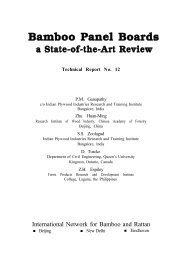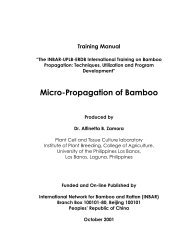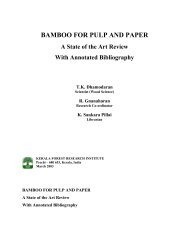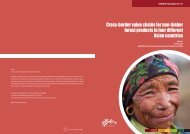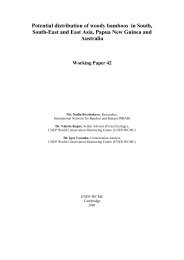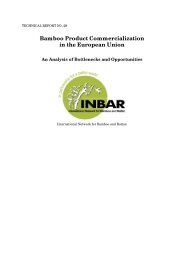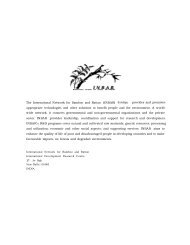The Bamboo and Rattan Sectors in Asia: an Analysis of ... - INBAR
The Bamboo and Rattan Sectors in Asia: an Analysis of ... - INBAR
The Bamboo and Rattan Sectors in Asia: an Analysis of ... - INBAR
Create successful ePaper yourself
Turn your PDF publications into a flip-book with our unique Google optimized e-Paper software.
2 DATABASE STUDIES<br />
One <strong>of</strong> the first activities supported by <strong>INBAR</strong> was a review <strong>of</strong> the socioeconomics<br />
bamboo <strong><strong>an</strong>d</strong> ratt<strong>an</strong> <strong>in</strong> Southeast <strong>Asia</strong> (Duraiappah 1993), which exam<strong>in</strong>ed<br />
the published literature <strong><strong>an</strong>d</strong> identified strengths <strong><strong>an</strong>d</strong> weaknesses <strong>in</strong> the current<br />
underst<strong><strong>an</strong>d</strong><strong>in</strong>g. <strong>The</strong> review showed that first steps had been made <strong>in</strong> m<strong>an</strong>y places,<br />
identify<strong>in</strong>g some <strong>of</strong> the ma<strong>in</strong> qualitative relationships <strong>in</strong> the economics, politics,<br />
sociology <strong><strong>an</strong>d</strong> ecology <strong>of</strong> the bamboo <strong><strong>an</strong>d</strong> ratt<strong>an</strong> sectors <strong>in</strong> the region. However, it<br />
also noted that there were major gaps, especially <strong>in</strong> qu<strong>an</strong>titative <strong>in</strong>formation:<br />
"Our prelim<strong>in</strong>ary f<strong>in</strong>d<strong>in</strong>gs suggest that there are not exist<strong>in</strong>g comprehensive<br />
databases <strong>in</strong> <strong>an</strong>y <strong>of</strong> the research <strong>in</strong>stitutions <strong>in</strong> the region... In fact, it is the<br />
dispersed nature <strong>of</strong> the data that seems to be the ma<strong>in</strong> deterrent rather th<strong>an</strong><br />
the non-existence <strong>of</strong> data. We, therefore, feel strongly that the establishment<br />
<strong>of</strong> a formal database is a prerequisite for <strong>an</strong>y further research <strong>in</strong> the sector."<br />
<strong>The</strong> <strong>INBAR</strong> Socio-economics Work<strong>in</strong>g Group (SEWG) responded by recommend<strong>in</strong>g<br />
a series <strong>of</strong> small studies to collate exist<strong>in</strong>g <strong>in</strong>formation, to assess its quality <strong><strong>an</strong>d</strong><br />
reliability, <strong><strong>an</strong>d</strong> to synthesize <strong><strong>an</strong>d</strong> <strong>an</strong>alyse it. It was felt that these studies would be useful<br />
at the national level, provid<strong>in</strong>g for the first time a national database on the bamboo <strong><strong>an</strong>d</strong><br />
ratt<strong>an</strong> sectors, <strong><strong>an</strong>d</strong> that they would serve as the start<strong>in</strong>g po<strong>in</strong>t for a regional database<br />
on the topic.<br />
As a beg<strong>in</strong>n<strong>in</strong>g, studies were carried out <strong>in</strong> Ch<strong>in</strong>a, India, Indonesia, Nepal <strong><strong>an</strong>d</strong><br />
the Philipp<strong>in</strong>es. Together, these studies demonstrate the very high economic value <strong>of</strong><br />
both commodities <strong>in</strong> the <strong>Asia</strong>n region.<br />
India <strong>Bamboo</strong> Database by the Indi<strong>an</strong> Council <strong>of</strong> Forestry Research <strong><strong>an</strong>d</strong> Education<br />
(ICFRE) shows that there are 10 million ha <strong>of</strong> bamboo, account<strong>in</strong>g for about 12.8% <strong>of</strong><br />
the total forest cover <strong>in</strong> the country. <strong>The</strong> same report gives bamboo production figures<br />
for some <strong>of</strong> the more import<strong>an</strong>t bamboo produc<strong>in</strong>g states. For example, <strong>in</strong> 1993, Orissa<br />
produced 290 000 tons <strong><strong>an</strong>d</strong> Madhya Pradesh 211 000 tons. In 1994, Andhra Pradesh<br />
produced 174 000 tons (<strong><strong>an</strong>d</strong> these figures account for only the production on state<br />
l<strong><strong>an</strong>d</strong>s.)<br />
<strong>Bamboo</strong> <strong><strong>an</strong>d</strong> ratt<strong>an</strong> socio-economic database for the Peoples Republic <strong>of</strong> Ch<strong>in</strong>a,<br />
prepared by Zhong et al. documents the growth <strong>in</strong> the total bamboo pl<strong>an</strong>tation area<br />
from 3.04 million ha <strong>in</strong> 1973 to 3.9 million ha <strong>in</strong> 1993. <strong>The</strong> st<strong><strong>an</strong>d</strong><strong>in</strong>g stock <strong>in</strong>creased<br />
from 67.54 million tons to 97.04 million tons <strong>in</strong> the same period, show<strong>in</strong>g <strong>an</strong> enormous<br />
<strong>in</strong>crease <strong>in</strong> productivity. From 1980 to 1993, harvests <strong>of</strong> bamboo shoots <strong>of</strong> the most<br />
import<strong>an</strong>t species have at least doubled, <strong><strong>an</strong>d</strong> <strong>in</strong> some cases <strong>in</strong>creased up to 8.5 fold.<br />
Exports have grown from US$111 million <strong>in</strong> 1981 to over US$318 million <strong>in</strong> 1993. In<br />
1992, there were around 30 000 bamboo <strong><strong>an</strong>d</strong> ratt<strong>an</strong>-based enterprises employ<strong>in</strong>g<br />
750 000 people, <strong>of</strong> which about 60% were women. Import<strong>an</strong>tly, the study notes that,<br />
unlike the modern forestry sector, wide participation by rural people characterize the<br />
4



